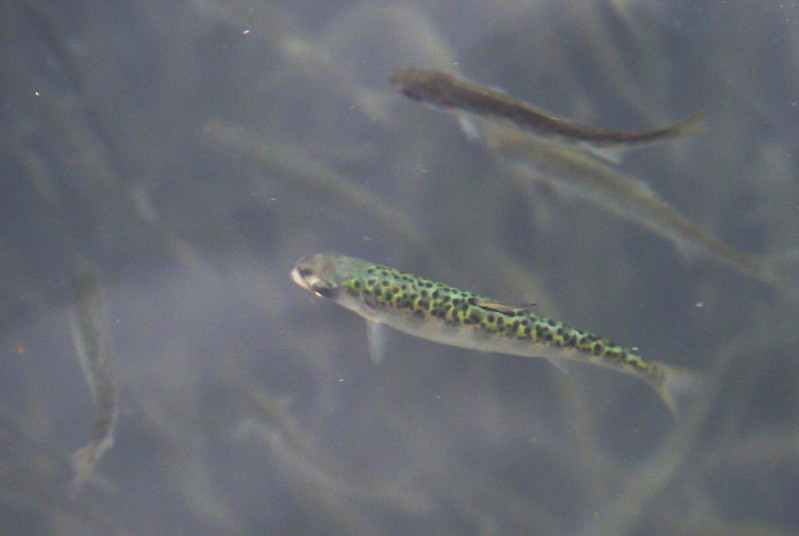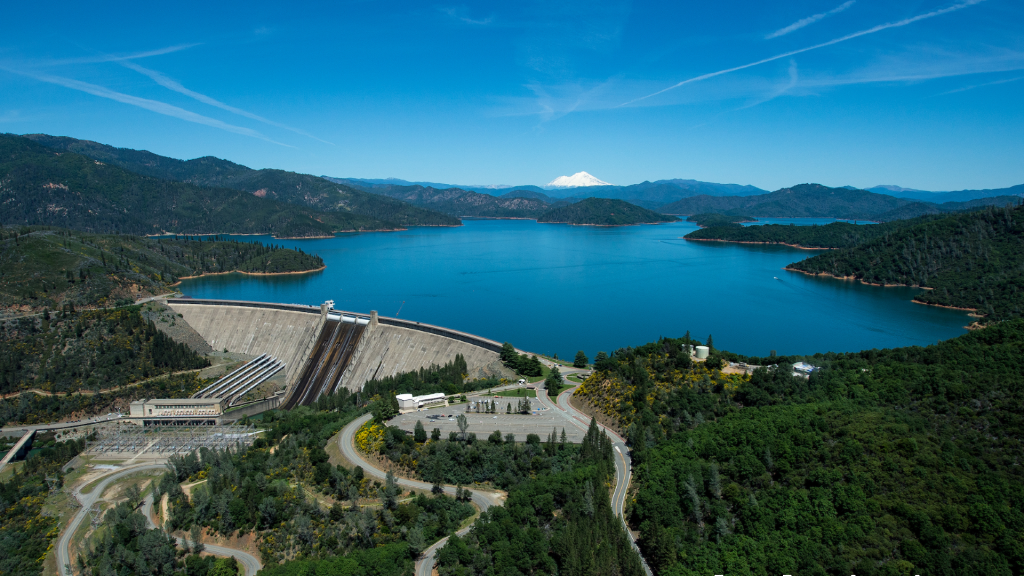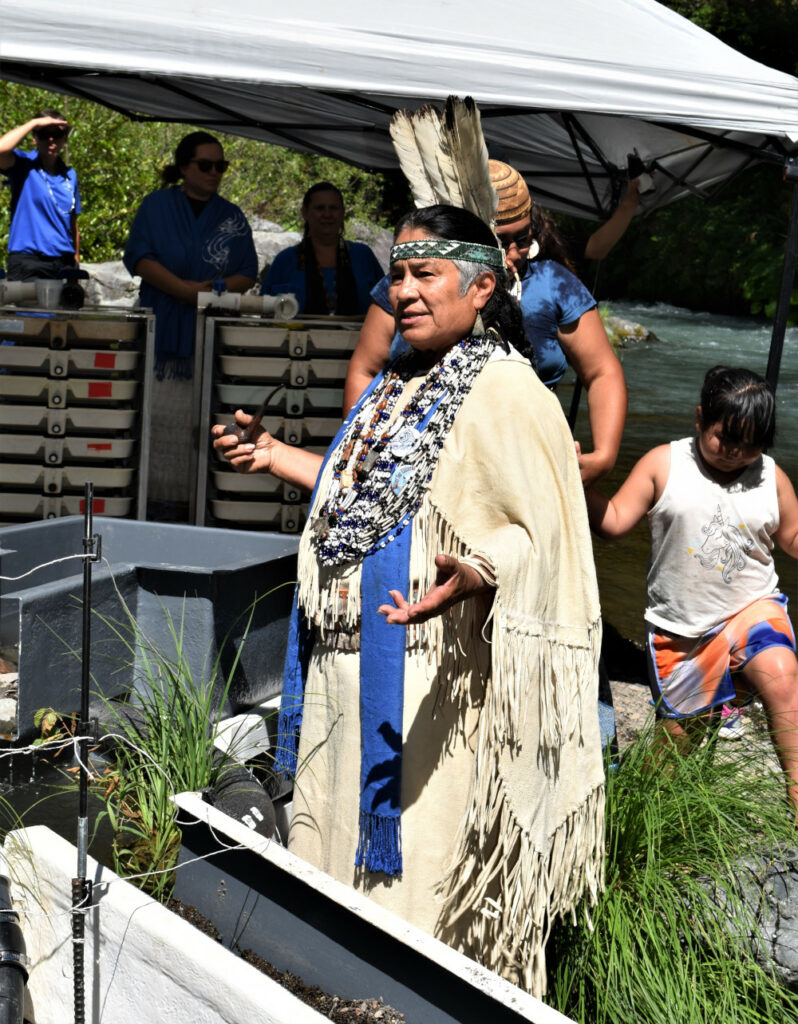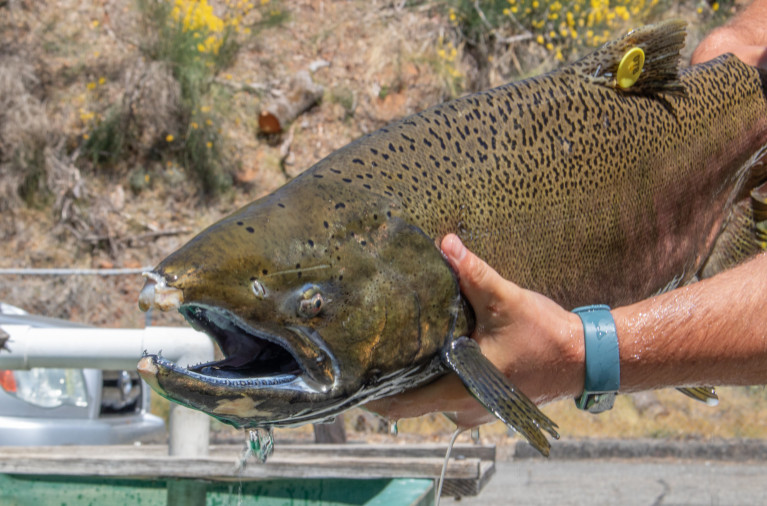Near McCloud Bridge, about 15 miles east of Interstate 5 in Northern California, lies one of the former village sites of the Winnemem Wintu. The Tribe still holds coming-of-age ceremonies on the river, which they also call Winnemem.
Backed up by Shasta Dam and reservoir, the river is wide and sluggish, flowing under McCloud Bridge and past the Forest Service campground, which is popular with anglers casting after the river’s famed trout. In late June temperatures rise by mid-morning and warblers sing from the generous canopies of the oaks shading the campsites.
From the bank below one of the campsites, Matt Johnson, senior environmental scientist at the California Department of Fish and Wildlife, points to a spot where he installed two rotary screw traps in the river last summer. The traps — each a large metal cone-and-trap box moored on twin floats — are typically to sample fish populations, but Johnson used them to catch young winter-run Chinook salmon fry who’d been released upstream.
“It was a duct tape and bailing wire emergency operation,” jokes Johnson, who had been brought onto the project just weeks before. “I had to use whatever I had on hand.”

Winter-run Chinook fry. Photo; Jake Sisco/USFWS
The project, part of an 11th-hour emergency action to help save winter-run Chinook from extinction, marked the first time these endangered, evolutionarily unique fish have been above Shasta Dam in 80 years.
“The McCloud was probably the worst river to dam in California,” says Johnson. “It’s incredible salmon habitat.”
The McCloud River is replenished by snow and glacier-fed springs on Mt. Shasta’s southern flank. The river winds through a labyrinth of basalt canyons before fattening into an arm of Shasta Lake. Salmon and steelhead once thrived in these waters, which flow cold even during drought.
Shasta Dam is the centerpiece of the Central Valley project, the audacious network of dams, reservoirs and canals that supply and deliver, on average, 7 million acre-feet of water to farmers and communities every year. When it was completed in 1944, the 602-foot dam cut off miles of salmon habitat, and the reservoir inundated nearly all the Winnemem Wintu’s ancestral territory, including many sacred sites.

Shasta dam and lake near Redding, Calif. Photo: Kelly M. Grow/ California Department of Water Resources
The Tribe, which is not federally recognized, does not own any land on the McCloud, but under the leadership of Chief Caleen Sisk, the Winnemem Wintu have spent the past 25 years fighting for their right to hold ceremonies on the river, opposing proposals to raise Shasta Dam even higher, and praying to return salmon, or Nur, to their rightful waters.
More recently state and federal agencies have joined that effort.
“Winter-run are a ‘species in the spotlight’ for us at NOAA,” says Rachel Johnson, salmon life history program lead for NOAA Fisheries Southwest Fisheries Science Center. “We recognize that they are some of the most vulnerable fish that we manage. We really need help moving the needle on their recovery.”
Eggs and young salmon need continual cold water to survive. Winter-run Chinook spawn in June and July, a strategy that worked well when they could reach the spring-fed reaches upstream. Now Chinook who return to spawn are trapped in the Sacramento River Valley near Redding, where summer temperatures reliably soar above 110 degrees Fahrenheit. The Bureau of Reclamation strategically releases cold water into the Sacramento River throughout the summer to aid fish that spawn below the dam.
“Nature cared for them in a much more brilliant, sustainable way,” says Rachel Johnson. “We’re trying to mimic that, but we’ve seen a continued decline.”
The Sacramento River winter-run Chinook population started crashing in the 1970s, and they became a federally listed endangered species in 1994. In 1997 the U.S. Fish and Wildlife Service built a special conservation hatchery at the base of Shasta Dam to help bolster the population. But little changed over the following two decades: The number of non-hatchery adults returning to spawn dwindled to just 153 individuals in 2017.
In 2021, following an anemic winter, Shasta Lake dipped to just 24% of capacity. The Bureau ran out of cold water, and Chinook ran out of luck.
That year, “there was essentially complete failure of all the winter-run that spawned,” says Matt Johnson.
As the drought persisted, Rachel Johnson heard from NOAA headquarters. “They wanted to know, what can we do to not let winter-run Chinook go extinct on our watch?”
The emergency pushed the agency to think creatively. Together with the state wildlife department and U.S. Fish and Wildlife Service, they outlined a suite of actions to help both winter-run and spring-run Chinook: trapping and relocating spawning adults to cold water tributaries; increasing production at the conservation hatchery; and treating gravid females with the equivalent of “prenatal vitamins” to offset thiamine deficiency, a new challenge related to poor ocean conditions.
Fish agencies had been wanting to reintroduce Chinook above Shasta Dam since at least 2009. Now, if they were going to save the species, they had to act quickly.
“This is a really hard thing to do,” says Matt Johnson. “You have a giant dam in the way of restoring salmon. It’s monumental in scope, money, planning and resources.”
They needed the Winnemem Wintu’s cooperation and knowledge, but the Tribe was resistant to introducing hatchery-bred eggs to their river because Chief Sisk believes that their true salmon relatives don’t dwell in the Sacramento River, but in streams on New Zealand’s South Island.
In a strange irony, fertilized Chinook eggs from the Baird Hatchery on the McCloud River were shipped all over the world, starting as early as the 1870s.
“The only place they survived was New Zealand,” says Chief Sisk.

Chief Sisk. Photo: Juliet Grable
For decades, the Winnemem Wintu had no idea these fish existed. Then, in 2004, they were contacted by Māori tribal members who had seen a film about the Tribe’s resistance to raising Shasta Dam. They were invited to travel to New Zealand in 2010 to reunite with the salmon.
“We have stories about salmon going through an ice waterfall in Mt. Shasta,” says Chief Sisk. She cites an ice waterfall on Aoraki, a mountain on New Zealand’s South Island, as further evidence that the salmon in both places are physically and spiritually connected.
The Tribe is advocating to bring these New Zealand Chinook home; in the meantime, Rachel Johnson met with Chief Sisk at the river to discuss using eggs from the conservation hatchery to carry out NOAA’s emergency action.
“I recall very vividly the language that she used,” says Johnson. “She said, ‘You know, I don’t recognize the fish that are below the dam — they are not familiar to me — but I am willing to bring them back here because they belong here.’ ”
Last summer, on two separate dates, the partners brought fertilized Chinook eggs to a campground on the McCloud River called AhDiNa, about 20 miles upstream of McCloud Bridge. They eventually released a total of 35,000 Chinook fry into the river. Over the next several months, Matt Johnson’s rotary screw traps caught 1,600 of the young fish, who were successfully trucked to a release site on the Sacramento River in Redding, below Shasta Dam.
The release was not a true reintroduction, but a pilot experiment, he says.
“What we did last summer numerically was not significant for recovery of winter-run Chinook salmon. But symbolically, it was a tremendous first step forward.”
This year the partners plan to release twice as many fish, and they will deploy a different, more effective trapping system. Water conditions in the river are also better. Most significantly, the relationships among the partners have been officially defined.
On May 1 Chief Sisk, on behalf of the Winnemem Wintu, signed a co-management agreement with California Department of Fish and Wildlife and a co-stewardship agreement with NOAA Fisheries. The agreements recognize the Tribe as an equal decision-making partner and pledge to incorporate traditional ecological knowledge and Tribal cultural values into restoration plans. The state wildlife department has also awarded the Tribe a $2.3 million grant to help fund its efforts to restore salmon.
During the signing ceremony, Chief Sisk spoke about the significance of the salmon’s return to the river and Winnemem Wintu homelands, and the role salmon play as both harbinger and provider of health.
“They are the messengers about water — about ocean water, about spring water, about all the waters,” she said. “They’re the ones who make water clear and pure and alive.”
![]()





